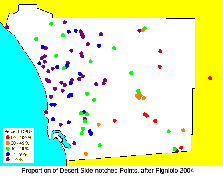Small Projectile Points
Small projectile points have been interpreted as indicators of chronological periods, ethnic identities, technologies, or activities in the archaeological record of Late Prehistoric San Diego County. The advent of bow-and-arrow technology, which the presence of small points seems to reflect, may have significantly altered the effectiveness of prehistoric hunters. It may also have altered power relations in favor of groups that acquired the bow and arrow as a weapon relatively early, creating the conditions for ethnic replacement or social reorganization.
The “small” projectile point class has been defined in a variety of ways (e.g., Lanning 1963; Thomas 1981; True 1970; Waugh 1988). A relatively inclusive definition would encompass all points that (1) weigh less than 3.0 grams, or (2) are shorter than 40 millimeters, or (3) are narrower than 20 millimeters and thinner than 6 millimeters.
 The earliest arrow-size projectile points recognized in the western Great Basin are corner-notched Rose Spring (or “Rosegate”) forms, generally dated between about A.D. 500 and 1250 (Justice 2002; Yohe 1992). Similar forms seem to be almost entirely absent from San Diego assemblages, although two obsidian specimens were reported from site SDI-4608 in Poway (McFarland 2000). Rose Spring points also seem to be absent from Orange County (Koerper et al. 1996). Possible alternative explanations for the local scarcity of Rose Spring forms are that bow-and-arrow technology spread to the San Diego area significantly later than to the western Great Basin or that other small point forms were adopted substantially earlier in San Diego than in the western Great Basin.
The earliest arrow-size projectile points recognized in the western Great Basin are corner-notched Rose Spring (or “Rosegate”) forms, generally dated between about A.D. 500 and 1250 (Justice 2002; Yohe 1992). Similar forms seem to be almost entirely absent from San Diego assemblages, although two obsidian specimens were reported from site SDI-4608 in Poway (McFarland 2000). Rose Spring points also seem to be absent from Orange County (Koerper et al. 1996). Possible alternative explanations for the local scarcity of Rose Spring forms are that bow-and-arrow technology spread to the San Diego area significantly later than to the western Great Basin or that other small point forms were adopted substantially earlier in San Diego than in the western Great Basin.
Two main types of small points have been distinguished in San Diego County sites: Cottonwood Triangular and Desert Side-notched points. Both types have been recognized throughout western North America, but some uncertainty exists as to the dating of their initial appearance:
 Robert F. Heizer and Thomas R. Hester (1978) reviewed radiocarbon evidence from the Great Basin and suggested that Desert Side-notched points had appeared after A.D. 1100-1200 (although they also noted some possible earlier occurrences) and that Cottonwood Triangular points had been present as early as A.D. 900-1100.
Robert F. Heizer and Thomas R. Hester (1978) reviewed radiocarbon evidence from the Great Basin and suggested that Desert Side-notched points had appeared after A.D. 1100-1200 (although they also noted some possible earlier occurrences) and that Cottonwood Triangular points had been present as early as A.D. 900-1100.- Claude N. Warren (1984) noted that Cottonwood Triangular points seem to have been present by A.D. 900-1100 in the western Mojave Desert, at which time Desert Side-notched points (as well as ceramics) were still absent. At Willow Beach on the Colorado River, Desert Side-notched points appeared after A.D. 1100.
- Jesse D. Jennings (1986), generalizing the chronological ranges of points in the Great Basin, assigned the Cottonwood Triangular type to the post-A.D. 1000 period, but he gave Desert Side-notched points a range beginning about A.D. 500.
- Henry C. Koerper, Adella B. Schroth, Roger D. Mason, and Mark L. Peterson (1996) suggested, primarily on the basis of associated radiocarbon dates, that Cottonwood series points had appeared as early as about A.D. 600 in Orange County.
- Noel D. Justice (2002) proposed ca. A.D. 900 as the date of the Cottonwood Triangular form’s initial appearance, and A.D. 1100-1200 for the appearance of Desert Side-notched points.
- Georgie Waugh (1986, 1988) considered possible chronological patterns underlying variations in the shapes of Cottonwood Triangular points. Waugh recognized three variants among the Cottonwood points from the Frey Creek site (SDI-731) in Pauma Valley and the Silver Crest site (SDI-217) on Palomar Mountain: straight base, broad base, and deep base. At Frey Creek, she found a higher proportion of deep base points in an early component (dated to ca. A.D. 1250) and a higher proportion of broad base points in a later component (ca. A.D. 1600). Koerper and his associates (1996) found no chronological patterning to Waugh’s subtypes in Orange County.

- D. L. True (1966) reported distinctions in the frequencies of different small projectile point forms between the archaeological assemblages in Luiseño and Kumeyaay territories. At sites in Cuyamaca and adjacent areas, True found that the proportion of Desert Side-notched points (his types #4 through #9 plus #11) was about 41%, whereas in the upper San Luis Rey River area the proportion was only about 3%. Consideration of some subsequent collections gives a general confirmation to the pattern, although with some anomalies. Sites located in the northern Kumeyaay (Ipai) area, primarily in coastal areas, show a low to intermediate frequency of side-notched points, which may make them more similar to the Luiseño than to the southern Kumeyaay pattern (Pigniolo 2004).

- A third, relatively uncommon point type, labelled “Dos Cabezas Serrated” (Wilke and McDonald 1986), consists of small points with deeply serrated edges. Philip J. Wilke and Meg McDonald (1986) suggested that this type might be functionally associated with the hunting of bighorn sheep.
PROSPECTS
Future archaeological investigations may be able to determine when small projectile points first appeared or became common in San Diego County, the chronologies for the various point forms (Rose Spring, Cottonwood, Desert Side-notched, and Dos Cabezas Serrated), and the functional or other explanations for the changes in point forms.